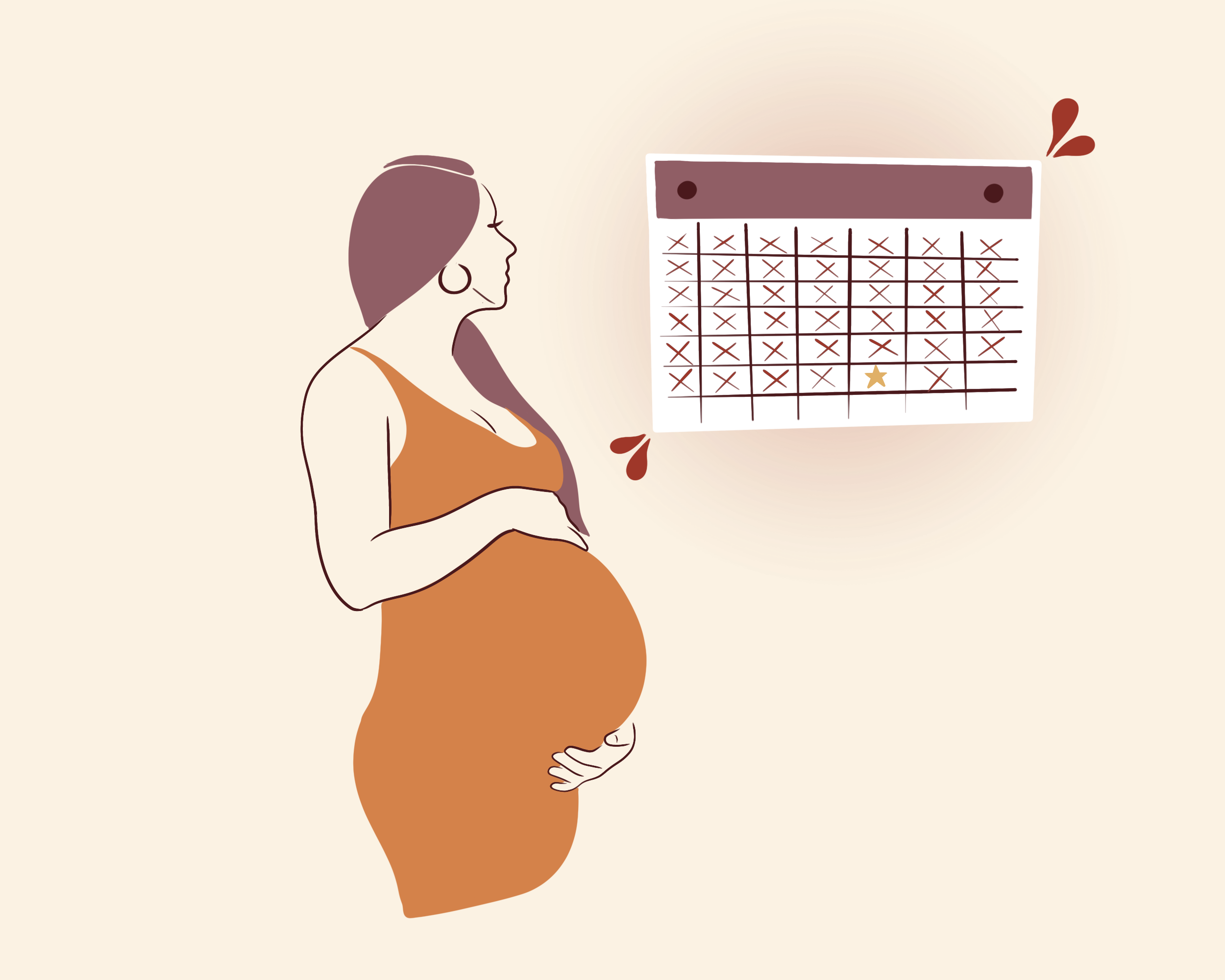Margot van Dijk
Gepubliceerd op 7 april 2022
Lange tijd werd er in Nederland een inleiding aangeboden als een zwangere nog niet was bevallen bij 42 weken zwangerschap. Inmiddels vindt er een verschuiving plaats: op steeds meer plekken wordt bij 41 weken zwangerschap een inleiding aangeboden en geadviseerd. De WHO (2018) adviseert een inleiding bij 41 weken, maar geeft wel aan dat de bewijskracht van dit advies laag is.
Hoe zit dit precies? Is het gevaarlijk om tot 42 weken of langer af te wachten? Wat zijn de mogelijke risico’s en hoe groot zijn die risico’s? Is een inleiding een beter alternatief dan afwachten en wat zijn de mogelijke voor- en nadelen daarvan? In dit artikel beantwoorden we deze vragen en meer.
Alkmark M, Keulen JKJ, Kortekaas JC, Bergh C, van Dillen J, Duijnhoven RG, et al. (2020) Induction of labour at 41 weeks or expectant management until 42 weeks: A systematic review and an individual participant data meta-analysis of randomised trials. PLoS Med 17(12): e1003436. https://doi.org/10.1371/journal.pmed.1003436
Balchin, I., Whittaker, J. C., Lamont, R. F., & Steer, P. J. (2011). Maternal and fetal characteristics associated with meconium-stained amniotic fluid. Obstetrics and gynecology, 117(4), 828-835. https://doi.org/10.1097/AOG.0b013e3182117a26
Bhide A. (2021). Induction of labor and cesarean section. Acta obstetricia et gynecologica Scandinavica, 100(2), 187-188. https://doi.org/10.1111/aogs.14068
Bricker, L., & Luckas, M. (2000). Amniotomy alone for induction of labour. The Cochrane database of systematic reviews, 2000(4), CD002862. https://doi.org/10.1002/14651858.CD002862
Buckley, S.J. (2015). Hormonal Physiology of Childbearing: evidence and implications for women, babies, and maternity care. Washington DC: Childbirth Connection Preagrams, National Partnership for Women & Families.
Dahlen, H. G., Thornton, C., Downe, S., de Jonge, A., Seijmonsbergen-Schermers, A., Tracy, S., Tracy, M., Bisits, A., & Peters, L. (2021). Intrapartum interventions and outcomes for women and children following induction of labour at term in uncomplicated pregnancies: a 16-year population-based linked data study. BMJ open, 11(6), e047040. https://doi.org/10.1136/bmjopen-2020-047040
Davey, M. A., & King, J. (2016). Caesarean section following induction of labour in uncomplicated first births- a population-based cross-sectional analysis of 42,950 births. BMC pregnancy and childbirth, 16, 92. https://doi.org/10.1186/s12884-016-0869-0
Espada-Trespalacios, X., Ojeda, F., Nebot Rodrigo, N., Rodriguez-Biosca, A., Rodriguez Coll, P., Martin-Arribas, A., & Escuriet, R. (2021). Induction of labour as compared with spontaneous labour in low-risk women: A multicenter study in Catalonia. Sexual & reproductive healthcare : official journal of the Swedish Association of Midwives, 29, 100648. https://doi.org/10.1016/j.srhc.2021.100648
Finucane, E. M., Murphy, D. J., Biesty, L. M., Gyte, G. M., Cotter, A. M., Ryan, E. M., Boulvain, M., & Devane, D. (2020). Membrane sweeping for induction of labour. The Cochrane database of systematic reviews, 2(2), CD000451. https://doi.org/10.1002/14651858.CD000451.pub3
Fox, H. (1997, 1 november). Aging of the placenta. ADC Fetal & Neonatal Edition. Geraadpleegd op 2 april 2022, van https://fn.bmj.com/content/77/3/F171
Gelisen, O., Caliskan, E., Dilbaz, S., Ozdas, E., Dilbaz, B., Ozdas, E., Haberal, A., 2005. Induction of labor with three different techniques at 41 weeks of gestation or sponta- neous follow-up until 42 weeks in women with definitely unfavorable cervical scores. Eur. J. Obstet. Gynecol. Reprod. Biol. 120, 164-169.
Grobman, W. A., Rice, M. M., Reddy, U. M., Tita, A., Silver, R. M., Mallett, G., Hill, K., Thom, E. A., El-Sayed, Y. Y., Perez-Delboy, A., Rouse, D. J., Saade, G. R., Boggess, K. A., Chauhan, S. P., Iams, J. D., Chien, E. K., Casey, B. M., Gibbs, R. S., Srinivas, S. K., Swamy, G. K., … Eunice Kennedy Shriver National Institute of Child Health and Human Development Maternal-Fetal Medicine Units Network (2018). Labor Induction versus Expectant Management in Low-Risk Nulliparous Women. The New England journal of medicine, 379(6), 513-523. https://doi.org/10.1056/NEJMoa1800566
Gülmezoglu, A. M., Crowther, C. A., & Middleton, P. (2012). Induction of labour for improving birth outcomes for women at or beyond term. The Cochrane database of systematic reviews, (4), CD004945. https://doi.org/10.1002/14651858.CD004945.pub2
Gunnarsdóttir, J., Swift, E. M., Jakobsdóttir, J., Smárason, A., Thorkelsson, T., & Einarsdóttir, K. (2021). Cesarean birth, obstetric emergencies, and adverse neonatal outcomes in Iceland during a period of increasing labor induction. Birth (Berkeley, Calif.), 48(4), 493-500. https://doi.org/10.1111/birt.12564
Hannah, M. E., Hannah, W. J., Hellmann, J., Hewson, S., Milner, R., & Willan, A. (1992). Induction of labor as compared with serial antenatal monitoring in post-term pregnancy. A randomized controlled trial. The Canadian Multicenter Post-term Pregnancy Trial Group. The New England journal of medicine, 326(24), 1587-1592. https://doi.org/10.1056/NEJM199206113262402
Heimstad, R., Skogvoll, E., Mattsson, L.A., Johansen, O.J., Eik-Nes, S.H., Salvesen, K.A. 2007. Induction of labor or serial antenatal fetal monitoring in postterm pregnancy: a randomized controlled trial. Obstet Gynecol. 109 (3), 609-17.
Hermus, M., Verhoeven, C., Mol, B. W., de Wolf, G. S., & Fiedeldeij, C. A. (2009). Comparison of induction of labour and expectant management in postterm pregnancy: a matched cohort study. Journal of midwifery & women's health, 54(5), 351-356. https://doi.org/10.1016/j.jmwh.2008.12.011
Kelly AJ, Alfirevic Z, Dowswell T. Outpatient versus inpatient induction of labour for improving birth outcomes. Cochrane Database Syst Rev 2009;(2):CD007372.
Keulen, J., Bruinsma, A., Kortekaas, J. C., van Dillen, J., van der Post, J., & de Miranda, E. (2018). Timing induction of labour at 41 or 42 weeks? A closer look at time frames of comparison: A review. Midwifery, 66, 111-118. https://doi.org/10.1016/j.midw.2018.07.011
Keulen JK, Bruinsma A, Kortekaas JC, van Dillen J, Bossuyt PM, Oudijk MA, Duijnhoven RG, van Kaam AH, Vandenbussche FP, van der Post JA, Mol BW, de Miranda E. (2019). Induction of labour at 41 weeks versus expectant management until 42weeks (INDEX): multicentre, randomised non-inferiority trial. BMJ. 20;364:l344. doi: 10.1136/bmj.l344.
Keulen, J., Nieuwkerk, P. T., Kortekaas, J. C., van Dillen, J., Mol, B. W., van der Post, J., & de Miranda, E. (2021). What women want and why. Women's preferences for induction of labour or expectant management in late-term pregnancy. Women and birth : journal of the Australian College of Midwives, 34(3), 250-256. https://doi.org/10.1016/j.wombi.2020.03.010
Kjerulff, K. H., Attanasio, L. B., Edmonds, J. K., Kozhimannil, K. B., & Repke, J. T. (2017). Labor induction and cesarean delivery: A prospective cohort study of first births in Pennsylvania, USA. Birth (Berkeley, Calif.), 44(3), 252-261. https://doi.org/10.1111/birt.12286
Kortekaas, J. C., Bruinsma, A., Keulen, J. K., van Dillen, J., Oudijk, M. A., Zwart, J. J., Bakker, J. J., de Bont, D., Nieuwenhuijze, M., Offerhaus, P. M., van Kaam, A. H., Vandenbussche, F., Mol, B. W., & de Miranda, E. (2014). Effects of induction of labour versus expectant management in women with impending post-term pregnancies: the 41 week - 42 week dilemma. BMC pregnancy and childbirth, 14, 350. https://doi.org/10.1186/1471-2393-14-350
KNOV. Factsheet naderende serotiniteit (laat-terme zwagerschap) (2015). Levine, E. M., Delfinado, L. N., Locher, S., & Ginsberg, N. A. (2021). Reducing the cesarean delivery rate. European journal of obstetrics, gynecology, and reproductive biology, 262, 155-159. https://doi.org/10.1016/j.ejogrb.2021.05.023
Lou, S., Hvidman, L., Uldbjerg, N., Neumann, L., Jensen, T. F., Haben, J. G., & Carstensen, K. (2019). Women's experiences of postterm induction of labor: A systematic review of qualitative studies. Birth (Berkeley, Calif.), 46(3), 400-410. https://doi.org/10.1111/birt.12412
Mandruzzato, G., Alfirevic, Z., Chervenak, F., Gruenebaum, A., Heimstad, R., Heinonen, S., Levene, M., Salvesen, K., Saugstad, O., Skupski, D., Thilaganathan, B., & World Association of Perinatal Medicine (2010). Guidelines for the management of postterm pregnancy. Journal of perinatal medicine, 38(2), 111-119. https://doi.org/10.1515/jpm.2010.057
McAlpine, J. M., Scott, R., Scuffham, P. A., Perkins, A. V., & Vanderlelie, J. J. (2016). The association between third trimester multivitamin/mineral supplements and gestational length in uncomplicated pregnancies. Women and birth : journal of the Australian College of Midwives, 29(1), 41-46. https://doi.org/10.1016/j.wombi.2015.07.185
Middleton, P., Shepherd, E., Morris, J., Crowther, C. A., & Gomersall, J. C. (2020). Induction of labour at or beyond 37 weeks' gestation. The Cochrane database of systematic reviews, 7(7), CD004945. https://doi.org/10.1002/14651858.CD004945.pub5
de Miranda, E., van der Bom, J. G., Bonsel, G. J., Bleker, O. P., & Rosendaal, F. R. (2006). Membrane sweeping and prevention of post-term pregnancy in low-risk pregnancies: a randomised controlled trial. BJOG : an international journal of obstetrics and gynaecology, 113(4), 402-408. https://doi.org/10.1111/j.1471-0528.2006.00870.x
Morken, N. H., Melve, K. K., & Skjaerven, R. (2011). Recurrence of prolonged and post-term gestational age across generations: maternal and paternal contribution. BJOG : an international journal of obstetrics and gynaecology, 118(13), 1630-1635. https://doi.org/10.1111/j.1471-0528.2011.03154.x
Muglu, J., Rather, H., Arroyo-Manzano, D., Bhattacharya, S., Balchin, I., Khalil, A., Thilaganathan, B., Khan, K. S., Zamora, J., & Thangaratinam, S. (2019). Risks of stillbirth and neonatal death with advancing gestation at term: A systematic review and meta-analysis of cohort studies of 15 million pregnancies. PLoS medicine, 16(7), e1002838. https://doi.org/10.1371/journal.pmed.1002838
Murzakanova, G., Räisänen, S., Jacobsen, A. F., Sole, K. B., Bjarkø, L., & Laine, K. (2020). Adverse perinatal outcomes in 665,244 term and post-term deliveries-a Norwegian population-based study. European journal of obstetrics, gynecology, and reproductive biology, 247, 212-218. https://doi.org/10.1016/j.ejogrb.2020.02.028
NVOG (2018). Protocol datering van de zwangerschap.
NVOG (2022). Federatie Medisch Specialisten. Beleid zwangerschap 41 weken. Geraadpleegd via: https://richtlijnendatabase.nl/richtlijn/beleid_zwangerschap_41_weken/beleid_zwangerschap_vanaf_41_weken.htmlop 26 maart 2022.
Oberg, A. S., Frisell, T., Svensson, A. C., & Iliadou, A. N. (2013). Maternal and fetal genetic contributions to postterm birth: familial clustering in a population-based sample of 475,429 Swedish births. American journal of epidemiology, 177(6), 531-537. https://doi.org/10.1093/aje/kws244
Olesen, A. W., Westergaard, J. G., & Olsen, J. (2003). Perinatal and maternal complications related to postterm delivery: a national register-based study, 1978-1993. American journal of obstetrics and gynecology, 189(1), 222-227. https://doi.org/10.1067/mob.2003.446
Olsen, O. (2019). Statistical analysis in SWEPIS trial is flawed. Peristat.nl (2020). Geraadpleegd op 26 maart 2022. Reed, R. (2019). Post-Dates Induction of Labour: balancing risks.
Rijnders, M. E. B. (2011). Interventions in midwife led care in the Netherlands to achieve optimal birth outcomes: effects and women's experiences
Rosenstein, M. G., Cheng, Y. W., Snowden, J. M., Nicholson, J. M., & Caughey, A. B. (2012). Risk of stillbirth and infant death stratified by gestational age. Obstetrics and gynecology, 120(1), 76-82. https://doi.org/10.1097/AOG.0b013e31825bd286
Rydahl E, Eriksen L, Juhl M. Effects of induction of labor prior to post-term in low-risk pregnancies: A systematic review. JBI Database Syst Rev Implement Reports. 2019a;17(2):170-208.
Rydahl, E., Declercq, E., Juhl, M., & Maimburg, R. D. (2019b). Routine induction in late-term pregnancies: follow-up of a Danish induction of labour paradigm. BMJ open, 9(12), e032815. https://doi.org/10.1136/bmjopen-2019-032815
Seijmonsbergen-Schermers, A. E., Scherjon, S., & de Jonge, A. (2019). Induction of labour should be offered to all women at term: AGAINST: Induction of labour should not be offered to all women at term: first, do no harm. BJOG : an international journal of obstetrics and gynaecology, 126(13), 1599. https://doi.org/10.1111/1471-0528.15887
Seijmonsbergen-Schermers, A. E., Peters, L. L., Goodarzi, B., Bekker, M., Prins, M., Stapert, M., Dahlen, H. G., Downe, S., Franx, A., & de Jonge, A. (2020). Which level of risk justifies routine induction of labor for healthy women?. Sexual & reproductive healthcare : official journal of the Swedish Association of Midwives, 23, 100479. https://doi.org/10.1016/j.srhc.2019.100479
Seijmonsbergen-Schermers, A.E. & de Jonge, A., 2020. Duiding van de Swepis studie. https://research.vumc.nl/ws/portalfiles/portal/13606376/Wetenschappelijke_duiding_SWEPIS_studie_2019.pdf
Wagenmakers, E.-J., & Ly, A. (2020). Bayesian scepsis about SWEPIS: Quantifying the evidence that early induction of labour prevents perinatal deaths.
Warland, J., & Mitchell, E. A. (2014). A triple risk model for unexplained late stillbirth. BMC pregnancy and childbirth, 14, 142. https://doi.org/10.1186/1471-2393-14-142
WHO: World Health Organization. (2018). WHO recommendations: Induction of labour at or beyond term. https://apps.who.int/iris/bitstream/handle/10665/277233/9789241550413-eng.pdf
Wennerholm, U. B., Saltvedt, S., Wessberg, A., et al. (2019). Induction of labour at 41 weeks versus expectant management and induction of labour at 42 weeks (SWEdish Post-term Induction Study, SWEPIS): Multicentre, open label, randomised, superiority trial. BMJ, 367:l6131.
Wickham, S. (2021). In Your Own Time: How Western Medicine Controls the Start of Labour and why this Needs to Stop. Birthmoon Creations. Zenzmaier, C., Pfeifer, B., Leitner, H., & König-Bachmann, M. (2021). Cesarean delivery after non-medically indicated induction of labor: A population-based study using different definitions of expectant management. Acta obstetricia et gynecologica Scandinavica, 100(2), 220-228. https://doi.org/10.1111/aogs.13989
Zhao, Y., Flatley, C., & Kumar, S. (2017). Intrapartum intervention rates and perinatal outcomes following induction of labour compared to expectant management at term from an Australian perinatal centre. The Australian & New Zealand journal of obstetrics & gynaecology, 57(1), 40-48. https://doi.org/10.1111/ajo.12576
>





Reacties